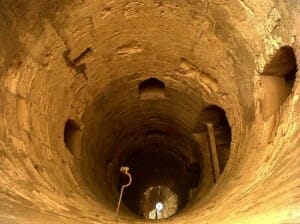
In the afternoon, we visited two Alexandrian landmarks- one ancient and one modern. Our first stop was at the Catacombs of Kom El-Shoqafa. After visiting the Roman Jewish catacombs, I was eager to visit the Catacombs of Kom El-Shoqafa, One of the Seven Wonders of the Medieval World . This site dates back to the 1st century of the Common Era. Like most other ancient burial sites, it was accidentally discovered centuries later.
Bus loads of people gathered near the entrance. Our group escaped the blazing sun by standing in a nearby shaded area. We entered a stuffy, dark cavern with limited ventilation. We walked down a circular staircase that had approximately 100 steps. Disappointingly, we were unable to take any photographs. I found the adjacent photo on the Trip Advisor website.
We observed pillars, statues, wall paintings and religious symbols. I faintly heard the guide mention that the artwork was a mixture of Egyptian, Greek, and Roman. It was not possible to hear most of what our guide said. This is the disadvantage of being part of a large tour group that is organized by a cruise line.
The lowest level of the catacomb was not accessible since it was submerged under water.
It was common practice for Christians and Jews to use catacombs during this time period. However, our guide claimed that these catacombs were for pagan sects of the pharaoh-cult members. By the time we returned back to ground level, we were sweating profusely and parched. Too many people were led into a tightly confined space that had limited ventilation. I suggest that you tour first thing in the morning with a smaller group.
Without any pictures, it is not possible to compare these catacombs with what we saw in Rome or what we would see a few days later in Israel.
Our last stop was the Bibliotheca Alexandrina. This modern structure was built on the site of the ancient library. The original library purportedly held the largest collection of manuscripts in the world and was considered a center of learning for approximately 600 years.
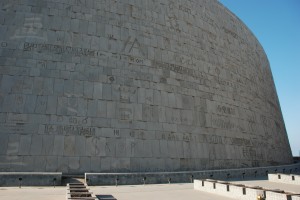
Today’s building boasts a 160m-diameter glass-panelled roof tilted out toward the sea like a sundial. Walking from the bus to the entrance we passed grey Aswan granite that had over a hundred different scripts.
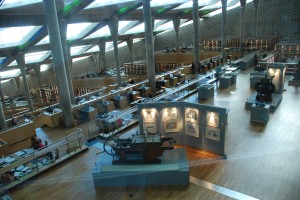
The main room was massive. Our guide mentioned that it could accommodate approximately 2,000 readers. The book collection included items that were donated from around the world.
We had a short amount of time to explore the library. Our first stop was the Sadat Museum. It was located at the far end of a long corridor. It was not something that could easily be located. We had to stop and ask a couple of people to make sure we were headed in the right direction. The display cases provided a good overview of President Anwar Sadat’s noteworthy life. Videos were also available. Unfortunately, we were prevented from taking any photographs.
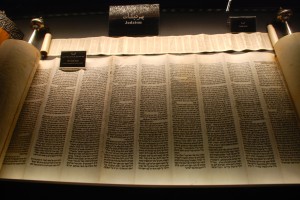
With a limited amount of time remaining, we hurried to the Manuscript and Rare Book Exhibition Gallery.This quiet room was dimly lit and filled with display cases. We were curious to see if the collection had any ancient Jewish books. To our delight we found a Torah.
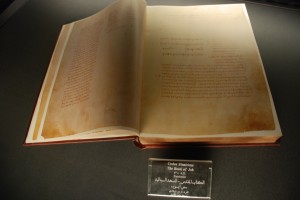
We also saw a copy of the Book of Job that was dated 4th Century CE.
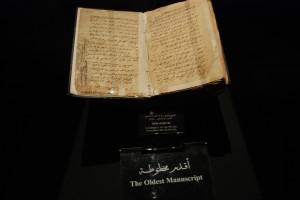
The oldest manuscript displayed in the room was a copy of the Quran.
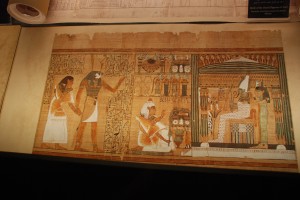
Colorful papyrus pictures were also showcased.
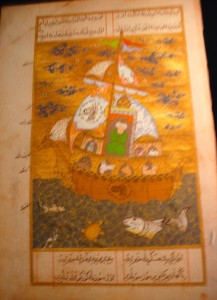
In addition to the display cases, there were different treasures mounted on the wall. This depiction of the biblical story of Noah caught our attention.
Once again, we wished that we had more time to explore. Nevertheless, we had an amazing time visiting sites during our afternoon in Alexandria, Egypt. I’m glad that we decided to take a Celebrity Cruise that included a two day stop in Alexandria
MAY THIS BE THE BEST YEAR OF YOUR LIFE is available on Amazon.
If you enjoyed reading my memoir, consider posting a review on Amazon, Goodreads, and/or AskDavid.com.
Leave a Reply
You must be logged in to post a comment.